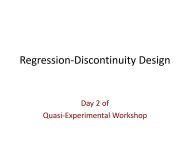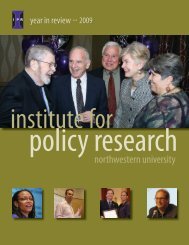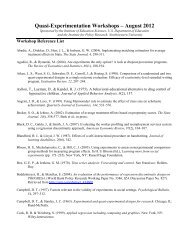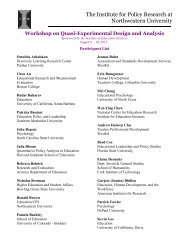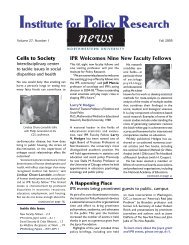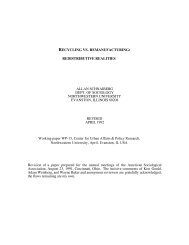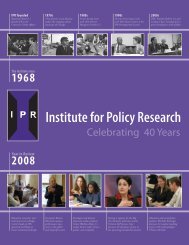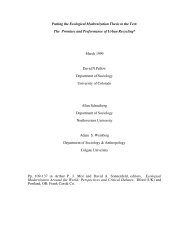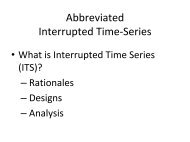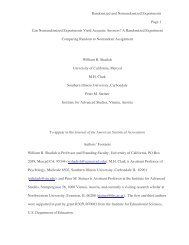pdf - Institute for Policy Research - Northwestern University
pdf - Institute for Policy Research - Northwestern University
pdf - Institute for Policy Research - Northwestern University
Create successful ePaper yourself
Turn your PDF publications into a flip-book with our unique Google optimized e-Paper software.
the Moving to Opportunity experiment.<br />
Journal of Human Resources 41(4): 649–91.<br />
Duncan, G., with E. Snell. 2006. Child<br />
characteristics and successful use of housing<br />
vouchers: Estimates from MTO.<br />
Housing <strong>Policy</strong> Debate 17(4): 727-54.<br />
Duncan, G., with K. Magnuson. 2006. The<br />
role of family socioeconomic resources in<br />
black and white test score gaps among young<br />
children. Developmental Review 26(4): 365-99.<br />
Duncan, G., and A. Zuberi. 2006. Mobility<br />
lessons from Gautreaux and Moving to<br />
Opportunity. Journal of Law and Social <strong>Policy</strong><br />
1(1): 110-26.<br />
Duncan, G., P. England, and B. Wilkerson.<br />
2006. Cleaning up their act: The effects of<br />
marriage and cohabitation on licit and illicit<br />
drug use. Demography 43(4): 691-710.<br />
Duncan, G. 2006. Family structure, poverty<br />
and family well-being. Employee Rights and<br />
Employment <strong>Policy</strong> Journal 10(1): 9-45.<br />
Duncan, G., and K. Magnuson. 2006. Costs<br />
and benefits from early investments to promote<br />
human capital and positive behavior.<br />
In The Crisis in Youth Mental Health: Critical<br />
Issues and Effective Programs, ed. N. Watt, et<br />
al., vol. 4, 27-51. Westport, Conn.: Praeger.<br />
Duncan, G., and J. Ludwig. 2006. Promising<br />
solutions in housing and the community. In<br />
Deviant Peer Influences in Programs <strong>for</strong> Youth:<br />
Problems and Solutions, ed. K. Dodge and T.<br />
Dishion, 312-27. New York: Guil<strong>for</strong>d Press.<br />
Duncan, G., and E. Clark-Kauffman and<br />
E. Snell. 2006. Residential mobility interventions<br />
as treatments <strong>for</strong> the sequelae of<br />
neighborhood violence. In Interventions <strong>for</strong><br />
Children Exposed to Violence, ed. A. Lieberman<br />
and R. DeMartino, 237-70. Johnson &<br />
Johnson Pediatric <strong>Institute</strong>.<br />
Duncan, G., with K. Magnuson and A.<br />
Kalil. 2006. The contribution of middle<br />
childhood contexts to adolescent achievement<br />
and behavior. In Developmental<br />
Context of Middle Childhood: Bridges to<br />
Adolescence and Adulthood, ed. A. C. Huston<br />
and M. H. Ripke, 150-172, New York: Cambridge<br />
<strong>University</strong> Press.<br />
Alice Eagly<br />
Eagly, A. H., and A. B. Diekman. 2006.<br />
Examining gender gaps in sociopolitical<br />
attitudes: It’s not Mars and Venus. Feminism<br />
and Psychology 16:26-34.<br />
Killeen, L. A., E. Lopez-Zafra, and A. H.<br />
Eagly. 2006. Envisioning oneself as a leader:<br />
Comparisons of women and men in Spain<br />
and the United States. Psychology of Women<br />
Quarterly 30:312-22.<br />
Eastwick, P. W., A. H. Eagly, P. Glick, M.<br />
Johannesen-Schmidt, and S. T. Fiske. 2006.<br />
Is traditional gender ideology associated<br />
with sex-typed mate preferences? A test in<br />
nine nations. Sex Roles 54:609-14.<br />
Eagly, A. H., and A. Koenig. 2006.<br />
Social role theory of sex differences and<br />
similarities: Implications <strong>for</strong> prosocial<br />
behavior. In Sex Differences and Similarities<br />
in Communication 2nd ed., ed. K. Dindia<br />
and D. J. Canary, 161-94. Mahwah, N.J.:<br />
Lawrence Erlbaum Associates.<br />
Eagly, A. H. 2006. Refereeing literature<br />
review submissions to journals. In Reviewing<br />
Scientific Works in Psychology, ed. R.<br />
Sternberg, 59-77. Washington, D.C.:<br />
American Psychological Association.<br />
Eagly, A. H., and W. Wood. 2006. Three<br />
ways that data can misin<strong>for</strong>m: Inappropriate<br />
partialling, small samples, and anyway,<br />
they’re not playing our song. Psychological<br />
Inquiry 17(2): 131-37.<br />
“Gautreaux One proves that<br />
families—both adults and their<br />
children—placed in affluent,<br />
integrated, and much safer<br />
neighborhoods are able to build<br />
new lives <strong>for</strong> themselves and<br />
maintain these residential successes.<br />
MTO and early results<br />
from Gautreaux Two suggest<br />
that neighborhood changes<br />
may be necessary but not sufficient<br />
conditions <strong>for</strong> improvement;<br />
many families in these<br />
more recent programs appear<br />
to need other supports in order<br />
to be truly successful.”<br />
Duncan, G., and A. Zuberi. 2006.<br />
Mobility lessons from Gautreaux<br />
and Moving to Opportunity. Journal<br />
of Law and Social <strong>Policy</strong> 1(1):<br />
110-26 (pp. 120-21).<br />
www.northwestern.edu/ipr 57



